► A love letter to the Ferrari 308
► Mark Walton plays Magnum PI
► Paying homage to an ’80s great
Back in the ’80s, I didn’t want to be Kevin Keegan or Nigel Mansell. I didn’t fantasise about being Luke Skywalker or Ozzy Osbourne or the man whose hand went up Basil Brush. No, I wanted to wear a flowery shirt, drive a Ferrari and live in Hawaii. I wanted to be Thomas Magnum, private investigator.
Magnum P.I. arrived on British TV in 1981, which makes me feel old but also nostalgic and fuzzy inside. This show had a profound effect on me, a boy who was just deciding that cars were more interesting than dinosaurs. I loved the way it ‘normalised’ the Ferrari 308 GTS – the way Magnum didn’t actually own the car, he only borrowed it; and he used it as his daily driver, which made the Ferrari seem so much more real.
Wait, you’re telling me you don’t know what I’m talking about? Okay, let’s rewind. Magnum P.I. premiered just as cop drama Hawaii Five-O ended its 12-year run. That’s no coincidence – Magnum was created, in part, to make use of the studio facilities that had been established in Hawaii.
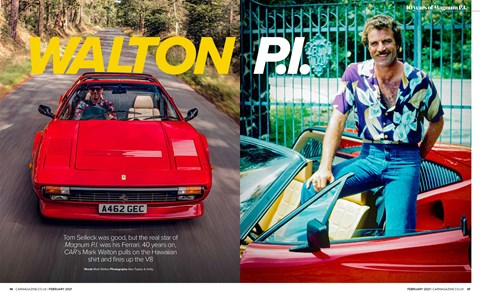
The plot followed the adventures of Thomas Magnum, played by 35-year-old Tom Selleck (above, right). Magnum was a Vietnam veteran who’d dropped out of the Navy Seals to become a private investigator, living on a beach- side estate owned by the wealthy, mysterious Robin Masters (voiced by Orson Welles but never seen on screen). The estate, Robin’s Nest, was run by a former British army officer, Higgins, played by John Hillerman (who was actually Texan). The quarrelsome relationship between Magnum and Higgins formed the backbone of the show: Higgins was the stiff military man, Magnum a laid-back rule-breaker who bunked in the guest house and borrowed the Ferrari for free.
Magnum was at the premium end of American TV popcorn. The scripts were clever and funny, the plots grown-up and complex, the tropical scenery and ocean views so glamorous and exotic. The series was shot on high-quality film, giving it a cinematic look compared to other Saturday night dross like The A-Team or Knight Rider. Watching the early episodes again, it’s striking how Magnum P.I. really began as a ’70s show. Most of the cars are classic ’70s Detroit iron, the street scenes full of square-edged Buick Regals and Lincoln Town Cars, and all the extras feel like they’ve just walked off the set of Saturday Night Fever.
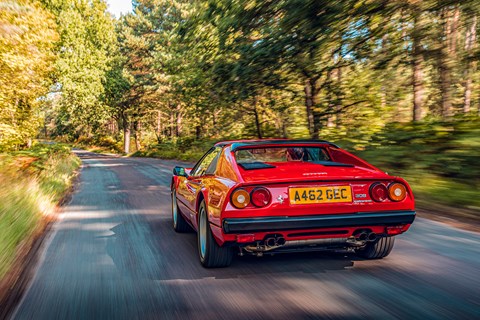
But two things really haven’t aged: Selleck’s look was styled around a beach-bum sports-jock, with his sneakers and jeans, the Vuarnet sunglasses and those Hawaiian shirts. And, of course, the Ferrari – though there wasn’t just one Ferrari, because the model changed over the show’s eight seasons. In 1980, Magnum drove a 1979 carburettor model, switch- ing to a fuel-injected GTSi in Season 2. In the final couple of years, it was a four-valve QV or ‘quattrovalvole’ model – though you’d need to be a geek to spot the differences. (Okay, seeing as we’re all geeks here: over the years changes included different door mirrors, louvred bonnet vents and the introduction of a small black ‘wing’ behind the cabin.)
The 308’s 2.9-litre V8 struggled to put out 200bhp in its fuel-injected guise, rising to just 236bhp in the later four-valve configuration. I didn’t realise how puny the 308 was back then – but I honestly didn’t care. Still don’t: the 308 GTB/GTS remains one of the most beautiful and underrated Ferraris ever built, a slender arrowhead of a car that blends the organic curves of the Dino with the crisp, paper-fold sharpness of a Countach.
Embarrassingly, I have to admit I used to wear the sunglasses and Hawaiian shirts back in the ’80s, and I have the pictures to prove it. I remember wondering why my ‘Magnum look’ never quite matched Selleck’s; something to do with my scrawny, feeble, beanpole shoulders and stringy teenage limbs perhaps.
And I never got to drive a Magnum 308. As a kid it seemed impossible – growing up in North Yorkshire, it felt like the nearest Ferrari was at least 300 miles away in every direction. Then the 308 was facelifted to become the blunt-nosed 328 in 1985, which in turn was replaced by the uglier, side-straked 348 in 1989. By the time I became a magazine road tester in the 1990s, Magnum’s Ferrari was already a 15-year-old classic.
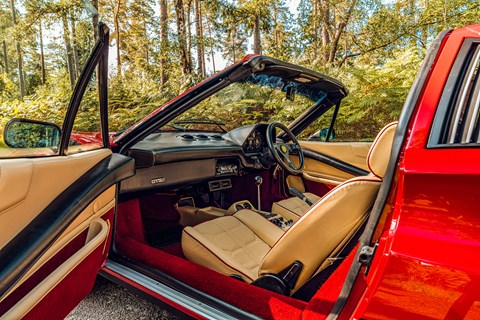
But its appeal never diminished, and because it remains one of the more affordable Ferraris I still occasionally surf the net, looking at left-hookers for under 50 grand, rarer right-hand-drive cars for £60k-£80k. Just browsing, of course… But maybe the anniversary of Magnum P.I. is just the excuse I need? To travel back in time to the ’80s, and finally live out a life-long dream? All I need to do is find an owner willing to lend me a car, dust down the Hawaiian shirt and start growing a moustache.
The Magnum P.I. theme tune is swirling around my brain as we pull up outside John Lawson’s house to find his beautiful 308 GTS waiting for us. John is a graphics editor, with 35 years of newspaper experience creating everything from economic bar charts to a cutaway drawing of Trump’s presidential limo. John shows us the project he did as a final-year student, when he trained as an illustrator: it’s a beautiful cutaway of a 308 GTB. ‘I wrote to Ferrari, asking for technical drawings and they sent me this,’ John says, unfolding an amazing blueprint of the 308. What a souvenir.
John has been a Ferrari fan and 308 devotee ever since. ‘Then the chancellor, George Osborne, allowed people to take cash out of their pension funds back in 2015,’ he tells me. ‘Remember all those headlines, about how people were going to blow the money on Lamborghinis? Well, I went out and bought a Ferrari.’
Yes, John seized the day, splashed the cash and fulfilled his life-long ambition by buying this gorgeous 1984 308 GTS QV, finished in classic Rosso Corsa with a ‘creme’ interior. The first thing that strikes me is how absolutely tiny it is. All cars have become bloated over the last 40 years, but at just 1.1 metres high, the 308 looks like a two-thirds scale model when you’re looking in through the open roof.
This was a problem while shooting Magnum P.I. – Selleck is 6ft 4in tall, and the production team had to pull the foam out of the driver’s seat and bolt it as far back as it would go, to allow him to fit. His head still stuck up above the windscreen, which is why it was rare to see him driving with the roof panel on. At only 6ft tall, this shouldn’t be a problem for me. And frankly, now I’ve got this far, I’ll chop my legs off at the ankles if I have to.
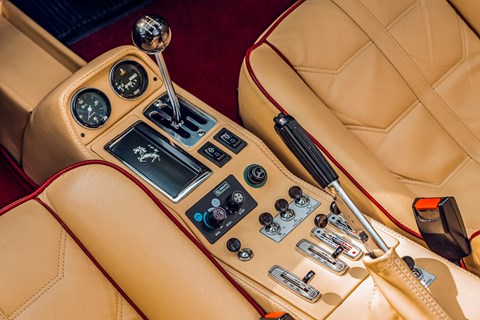
The door handle is a tiny black pull, hidden in the window frame. The door swings open, revealing Italian interior heaven. The flat leather cush- ions are firm and supportive. Simple and functional, this interior is a shrine to the Ferrari religion, full of symbols and icons that any true believer would recognise: the toggle switches and dials that fill the centre console; the steering wheel, jutting out, that logo glowing vibrant yellow like a stained-glass miniature; and as your left hand gently rests on the black ball on top of the gearlever, you gentle nudge it, side to side, clack-clack-clack in the metal gate. Man and machine meet in Holy Communion.
The V8 starts with a twist of key and stab of throttle. There is no American muscle-car burble, just a throaty exhaust rasp and a multi-valve sewing-machine whirr. The clutch is light. Snick that gearlever over to the left and back, for that classic dogleg first, and we’re off. Without a Magnum-style tail-slide slew across the grass, I hasten to add, though the thought did cross my mind.
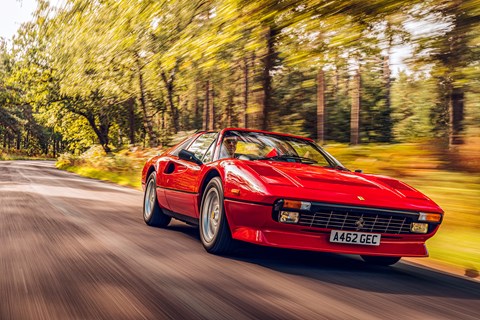
John’s car is one of 233 right-hand-drive examples, out of a total of 3042 GTS QVs (give or take – Ferrari production numbers are always opaque). Its right-handedness makes it easy to acclimatise: the driving position is better than I expected, and apart from little quirks like not engaging second until it’s warmed through, it feels more Mazda MX-5 than Murciélago in its mellow, generous nature.
You sit wonderfully low and laid-back, and the steering, unassisted and stiff at parking speeds, soon lightens beautifully, without losing any of its feedback. It’s a reminder to anyone living on a modern diet of electric power steering just what we’re missing. It’s so accurate, so alive, so connected. Even at lower speeds, it’s a thrill to steer it.
And then, if you press on, the magic really begins. The throttle response has a satisfying immediacy at lower revs, but by today’s standards this isn’t a fast car. The engine reacts, but there’s no slam of acceleration – the revs climb eagerly, but the 0-62mph time is still over six seconds (6.1 or 6.4sec, depends on your source). A modern VW Golf R would stomp on it.
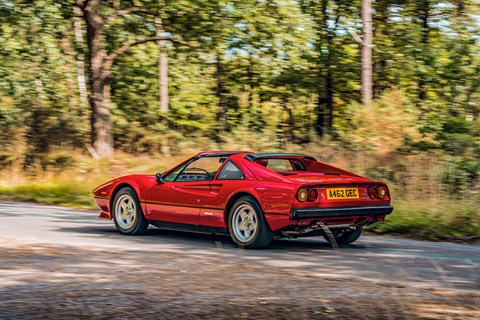
But when you get to the sweet spot, between 5000 and 7000rpm, there’s no denying the incredible urgency and intensity of this 38-year-old car. In gear at higher revs it is fast, and the noise becomes much more raucous, climbing to a momentary howl before you shift up.
And driving like this, the gearchange becomes absolutely central to the whole experience – it’s the punctuation in the sentence. The gearstick is long, but you can tell the engineers that developed the 308 were real enthusiasts, just the way that black snooker ball falls to hand so naturally, the way the gearing is so perfectly matched to engine speed, to maintain your high-revving, high-voltage momentum. It just flows – despite the gearchange being so slow compared to a modern paddleshift. There’s a tug-release-jam sensation with every gear, as you pull it out of a cog, through the gate and wedge it into the next gear. It’s mechanical but fluid, rubbery yet also metallic. Basically I could have revved it up and down that gearbox all day long. All. Day. Long.
I can’t tell you, the relief! I didn’t want my memories ruined. Before embarking on this story, I rewatched a load of Magnum P.I. episodes on Amazon Prime, and I was so pleased it hadn’t lost its charm, its humour or its quality. And thankfully the 308 GTS didn’t disappoint either. It’s still an amazingly engaging car, so emotional compared to today’s fast but sterile supercars. I couldn’t help thinking, surely there’s still room for a car like this in Ferrari’s line-up? A lightweight, 250bhp sports car: manual, analogue, unassisted, with lots of little toggle switches?
In the end, only my moustache let the side down. What moustache? Exactly.
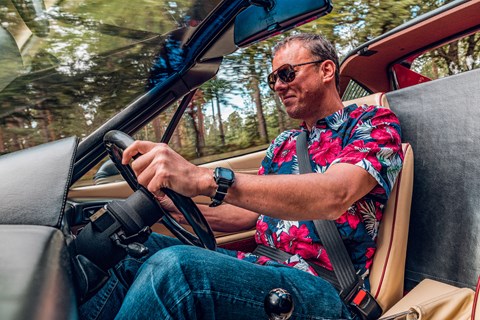
Ferrari 308 buying guide
- Know your 308s: The GTB launched in 1975 with a dry-sump V8 and a glassfibre body, though structural elements are steel (so rust still very much an issue…) and bonnet aluminium. Ferrari switches to steel in ’76, adding weight. GTS is the Spider, from ’77, and fuel injection comes in from ’80, though power actually drops. Italy and New Zealand get the tax-dodging 1990cc V8.
- Don’t get hung up on an early glassfibre car: Yes, they’re ‘pure’ and rare, but the steel underneath can still corrode and the glassfibre gelcoat can craze which isn’t a cheap fix. The later 308 QV is better value, and its steel body is easy to repair. The most affordable 308 is the GTSi at around £60k.
- Be prepared to spend… Servicing, while not cheap, is comparable to other thoroughbred classics like the Jaguar E-Type. Budget £2k-3k a year. The engine’s tough but clutches aren’t – they last around 30,000 miles – and you’ll need to replace the cambelt every four years.